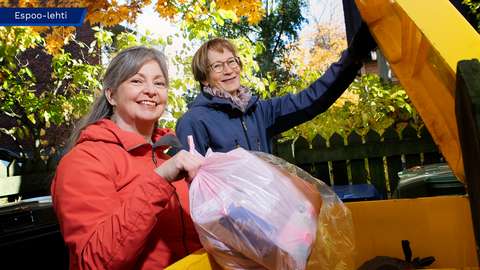Your waste is a valuable raw material

Waste should always be sorted so that materials can be reused and valuable natural resources are saved. Every resident in Espoo can learn to reduce the emissions caused by their consumption by sorting their waste correctly and reducing food waste.
Successful waste management makes our neighbourhoods tidier: when waste is sorted and disposed of properly, Espoo remains pleasant and clean. In addition, sorting has much broader positive effects.
“Sorting is really important for the environment and climate. The more materials are reused, the less valuable natural resources are needed to manufacture the products,” explains Development Manager Reetta Jänis.
The Carbon-neutral Espoo 2030 roadmap is the city’s plan and strategy for achieving carbon neutrality by 2030. The roadmap includes concrete measures through which Espoo will reduce greenhouse gas emissions and promote sustainable development.
Emissions have been reduced faster than anticipated, especially in terms of traffic and energy production. Espoo also aims to increase recycling and reduce the amount of waste.
“The consumption of goods and services accounts for about a fifth of the emissions, so the development of our circular economy has a big effect,” says Development Manager Niina Nousjärvi.
Sorting is required by law
Sorting means that not all waste is thrown in the same bin. Instead, combustible mixed waste, compostable bio-waste, paper, cardboard, metal, glass and plastic are sorted into separate bins.
Since 2023, the Waste Act has stipulated that each property must have mixed waste and bio-waste containers. If there are more than five apartments in a housing company, the waste collection point must also have containers for cardboard, glass, metal and plastic.
Helsinki Region Environmental Services (HSY) collects waste for further processing. Mixed waste is burned in a waste-to-energy plant, producing electricity and heat. Cardboard is used as a raw material for new cardboard products, insulation products and fibre packaging.
“For example, toilet paper and kitchen roll cores are made from recycled cardboard packaging. Similarly, glass and metal are recycled into raw materials,” Jänis says.
Plastic from food packaging is also recycled into packaging materials, and plastic waste that cannot be recycled is burned to produce energy.
There is a need for much more recycled plastic.
“From the recycling perspective, it does not matter much how clean the plastic packaging, for example food wrapping or a shampoo bottle, is. The plastic is needed anyway,” Jänis says.
Bio-waste does not belong in the mixed waste bin
Although people in Espoo already sort their waste quite well, there is still a lot of room for improvement, especially concerning compostable waste: mixed waste still contains up to 40% bio-waste, which is then burned.
“Burning wet waste is absurd. You should put all leftover food in the compost. When done correctly, composting is a clean and tidy job, so there is no reason to avoid it,” Jänis says.
The soil produced by your own composter can be used as a nutritious growth medium in your garden. The compostable waste collected by HSY is taken to the Ämmässuo eco-industrial centre, where it is processed into biogas and soil.
Good planning reduces waste
The production and preparation of food affects the climate and the environment, so food should never be wasted. For several years, schools and day care centres in Espoo have been effectively reducing food waste.
“When food is tasty, there is less waste. That is why pupils have also been involved in the planning of meals,” says Minna-Leena Ahola, Director of Catering Services in Espoo.
In schools and day care centres, food orders and preparation are carried out precisely, according to consumption. The tips from schools on how to reduce food waste can also be used at home.
“At home, you can also plan a menu for a week and only buy the ingredients you need. It is a good idea to check the refrigerator before going to the grocery store, as stock rotation is an important way of reducing household waste,” Ahola says.
Vegetarian food is becoming more popular
School meals play an educational role in making new healthy and environmentally friendly dishes better known.
“For example, it takes some time to get used to the taste of legumes and plant-based proteins. You should also try new products or partially replace meat with plant-based products at home,” Ahola says.
Children’s environmentally friendly eating habits can actually surprise the parents. Slow-cooked porridge, for example, is one of the favourites at school.
“Spinach pancakes, vegetable nuggets and balls, and pasta-based vegetarian dishes are also popular, so it is a good idea to offer them at home too,” Ahola says.
Text: Susanna Cygnel
This article has originally been published in the Espoo-lehti 3/2024. Read other articles in the Espoo-lehti.